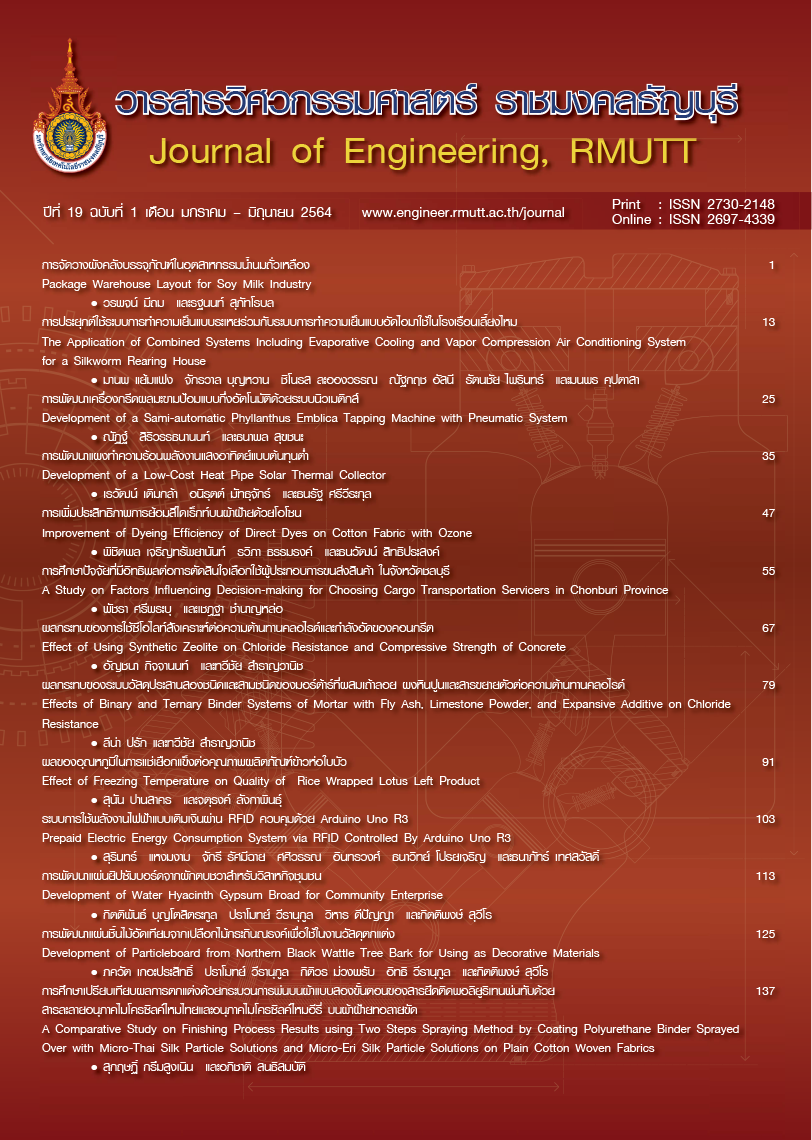Development of a Low-Cost Heat Pipe Solar Thermal Collector
Main Article Content
Abstract
The objective of this research is to develop a low-cost heat pipe solar thermal collector. A 1.5 m2 flat-plate solar thermal collector equipped with 12 heat pipes as heat transfer elements to the water manifold was designed and tested. The performance of the solar thermal collector was tested following the ASHRAE standard 93-77. The following water flow rates in the manifold were adjusted; 40, 60, and 80 L/hr. The current results show that the water outlet temperature greatly depends on solar radiation intensity and the water flow rate in the manifold. The maximum water outlet temperature of 53°C can be achieved when the water flow rate of 40 L/hr. and average solar radiation of 3.95 kw/m2 were applied. A maximum thermal efficiency of 55.61% can be reached when the water flow rate of 80 L/hr. and the average solar radiation of 3.39 kW/m2 were applied. From the analysis, the maximum total heat loss of the collector of 3.40 W/m2 can be found at the water flow rate of 40 L/hr. followed by the total heat loss of 2.60 W/m2 at a water flow rate of 60 L/hr. and 1.63 W/m2 at a water flow rate of 80 L/hr., respectively. From the simple economic analysis, a payback period of 1.35 years was obtained for this low-cost heat pipe-solar thermal collector. This is found to be a shorter payback period compared with that of the conventional commercial flat plate solar collector (2.25 years) and the vacuum solar collector (1.54 years).
Article Details
The manuscript, information, content, picture and so forth which were published on Frontiers in engineering innovation research has been a copyright of this journal only. There is not allow anyone or any organize to duplicate all content or some document for unethical publication.
References
Promnamchum S, Nuanplub K, Plangklang B, Biansoongnern S. Measurement and display system for solar radiation. Journal of Engineering RMUTT.2007;10(2):87-92. (in Thai)
Department of Alternative Energy Development and Efficiency. Solar water heater (Hybrid Solar water heater system) Ministry of Energy. [Internet]. 2013 [cited 2020 Jan 25]. Availablefrom:http://www.tsus.co.th/ download /d4.pdf. (in Thai)
O’Hegarty R, Kinnane O, McCormack S. Parametric analysis of concrete solar collectors. International Conference on Solar Heating and Cooling for Buildings and Industry. Energy Procedia. 2016;91:954-62.
Sukchai S, Suriwong T, Chamsa-ard W, Sonsaree S, Laodee P. The development of flat plate solar collector integrated with compound parabolic concentrator (CPC). [Research]. School of Renewable Energy Technology: Naresuan University; 2013. (in Thai)
Sirisamphanwong C, Ngoenmeesri R, Ketjoy N, Chamsa-ard W. Determination of annual energy yield of solar conllector. Naresuan University Journal: Science and Technology (NUJST). 2013;20(1):16-23. (in Thai)
Nshimyumuremyi E, Junqi W. Thermal efficiency and cost analysis of solar water heater made in Rwanda. Energy Exploration & Exploitation 2019;37(3):1147–61
Struckmann F. Analysis of a flat-plate solar collector. Project Report 2008-MVK160. Heat and Mass Transport. [Internet]. Lund, Sweden. [cited 2020 May 25]. Available from: http:// www.lth.se/fileadmin/ht/ Kurser/MVK160/Project_08/Fabio.pdf
Department of Alternative Energy Development and Efficiency. Project to promote the use of hot water from solar energy with an integrated system, 3rd. Ministry of Energy. [Internet]. 2012. [cited 2020 Jan 15]. Available from: http://webkc.dede.go.th/ testmax/sites/default/files. (in Thai)
Ashrea Standard 93-77. Methods of Testing to Determine the Thermal Performance of Solar Collectors. New York: The America Society of Heating Refrigerating and Air Conditioning Engineers. 1978.


